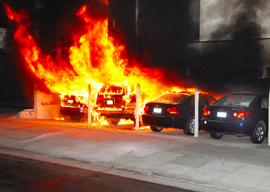
January 08, 2012

The New Year literally blazed into Los Angeles with dozens of fires set over several days. One of the worst arson attacks ever, it sent Angelenos scurrying for their garden hoses. As conflagrations broke out under cars and spread to nearby structures, many Angelenos were terrified it was a terrorist plot wreaking havoc in the night.
When the culprit was finally nabbed, the truth was less fearsome than an al-Qaeda plot but more bizarre—which suits Los Angeles. The alleged arsonist is Harry Burkhart, a 24-year-old Russian-born German national. He reportedly set the fires to protest the impending deportation to Germany of his mother Dorothee, an older woman doggedly eking out a living in the erotic-massage trade. She’s facing fraud charges in Germany. Young Harry, who is autistic, is also alleged to have set fires in Canada and Germany. Then Dorothee claimed that Nazis were stalking them. The back story loomed more peculiar as facts oozed out.
As Dorothee’s courtroom antics became more histrionic, interest shifted from son to mother. LA radio hosts John and Ken demanded she be allowed to stay merely for her entertainment value. Relief was palpable as January’s fires receded from clear and present danger to circus freak show.
Californians have a unique relationship with fire which exceeds the inbred fear every urbanite has for arson. Los Angeles has reason to fear conflagration—not merely for destroying lives and property but for its sociological symbolism. Anyone who lived through the Watts Riots or those of 1992 sees fire as a sign of our own personal apocalypse.
That apocalypse need not involve disadvantaged hordes marching north to plunder Hollywood like so many villagers setting out to burn Frankenstein’s castle. No, nature herself sometimes makes a frightful show during the dreaded “fire season.” Those living in or near our great brush-filled regions dread this summer-to-autumn period every year.
My introduction to it came in 1971, when my family was ensconced in the San Fernando Valley’s upper reaches. As the forest fire on the San Gabriel Mountains’ far slopes spilled over the peaks and became visible from our street, the neighbors brought out picnic tables and chairs to hold an impromptu block-party-cum-disaster-viewing. The flames lurched halfway down the slopes before the firemen stopped them.